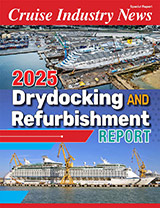The Port of Valencia has announced that the port and the region has lost 56 million euros since cruise service was suspended last year.
The impact of the cruise industry as estimated by the Valenciaport Foundation is 145.5 euros per passenger who disembarks. The cruise traffic is also said to support 637 local jobs.
Meanwhile, Valenciaport said it is working with the local community on creating “bubble” excursions to guarantee the safety of its citizens and the cruise passengers once the ship returns.
The port said in a prepared statement: “The crisis generated by the Covid-19 pandemic has paralyzed many economic sectors, some of them, such as tourism, is of great importance for our country and for regions such as Valencia. Among the visitors arriving in our territory, one of the most affected has been the cruise passenger. The virus paralyzed cruise tourism worldwide. In Spain, since the central government decreed a state of alarm and banned this activity (as in the rest of Europe), there has already been a year without cruise ships (except for the Canary Islands, which began operations this winter with coastal cruises).
The Port of Valencia reported 383,000 cruise passengers in is fiscal year 2017.
According to the Polytechnic University of Valencia (UPV), the cruise-related revenue in the city and the surrounding area of 56 million euros is due to 25.3 million euros of initial spending by the ships, passengers and crew, which, it said, has a multiplier effect of 1.21 euros on the Valencian economy of 30.7 million euros.
The passengers support activity in shops, museums, restaurants, etc., and they also generate business for transportation, taxis, security and port services. The UPV’s breaks down the revenue as follows: 17.5 million euros are from cruise passengers, 7.2 million euros from the companies involved (for pilots, tugboats, shipping agents, terminal, tour operators, etc.) and 0.6 million euros from the crew. From this initial outlay, an additional turnover of 30.7 million euros is generated in the Valencian economic sectors; a figure that results from the expenditure made in commerce, hotels, transport, cultural services and food, among others.
Cruise passengers visiting Valencia are mostly Europeans; 19.3% from Italy, 19% from Germany, 17.9% from England and 10.6% from France. Among the countries outside the old continent, 10.2% of tourists came from the United States.
The average length of stay ashore is 4.1 hours for passengers who have booked an excursion and 4.7 hours for those who disembark without a guided tour from the ship.
The average cruise tourist is 52 years. By age group, 37.9% are over 60 years old, 33.2% are between 41 and 60 years old, 15.4% are between 21 and 40 years old, and 13.6% are under 20 years old. In terms of gender, 52.4% are women and 47.4% men.
During the halt in cruise activity, the port authority is working with cruise lines and tour operators on “safe tourism,” with strict safety protocols and new land programs promising a diversified range of excursions, in order to be prepared for the “new normal” and receive cruise passengers arriving at the port again when the different authorities involved will allow cruise ship calls.
New protocols establish exclusively guided excursions, with no possibility for passengers to go off on their own, small groups and more outdoor experiences, among others.
Among Valenciaport’s new developments is also a new passenger terminal which will be used for both regular ferry lines and cruise ships.




